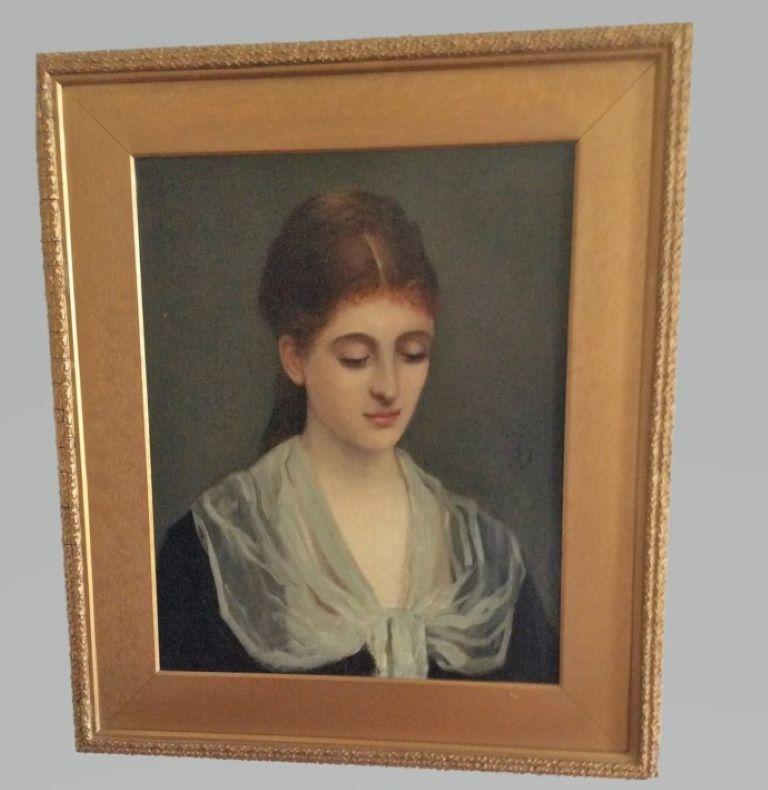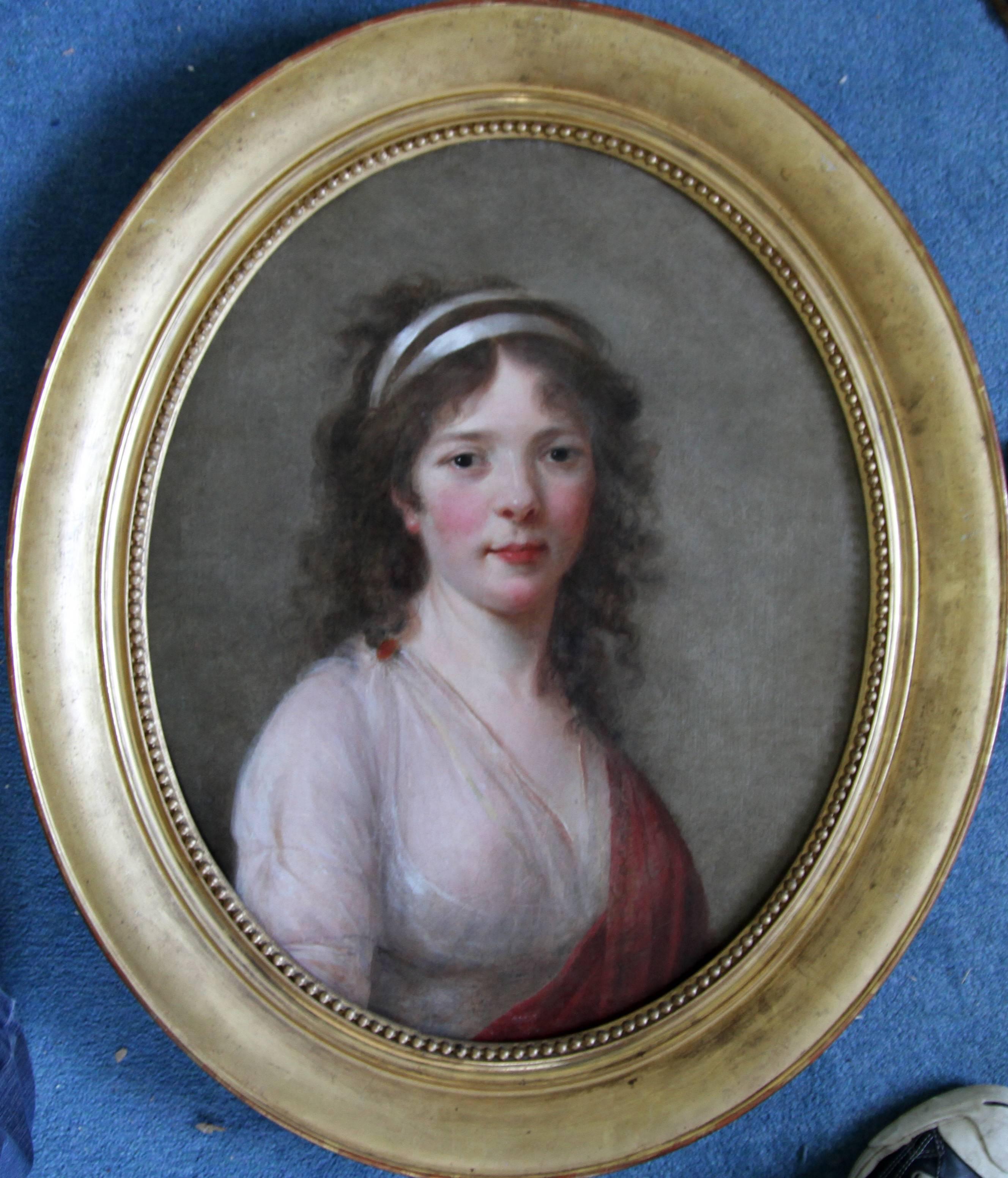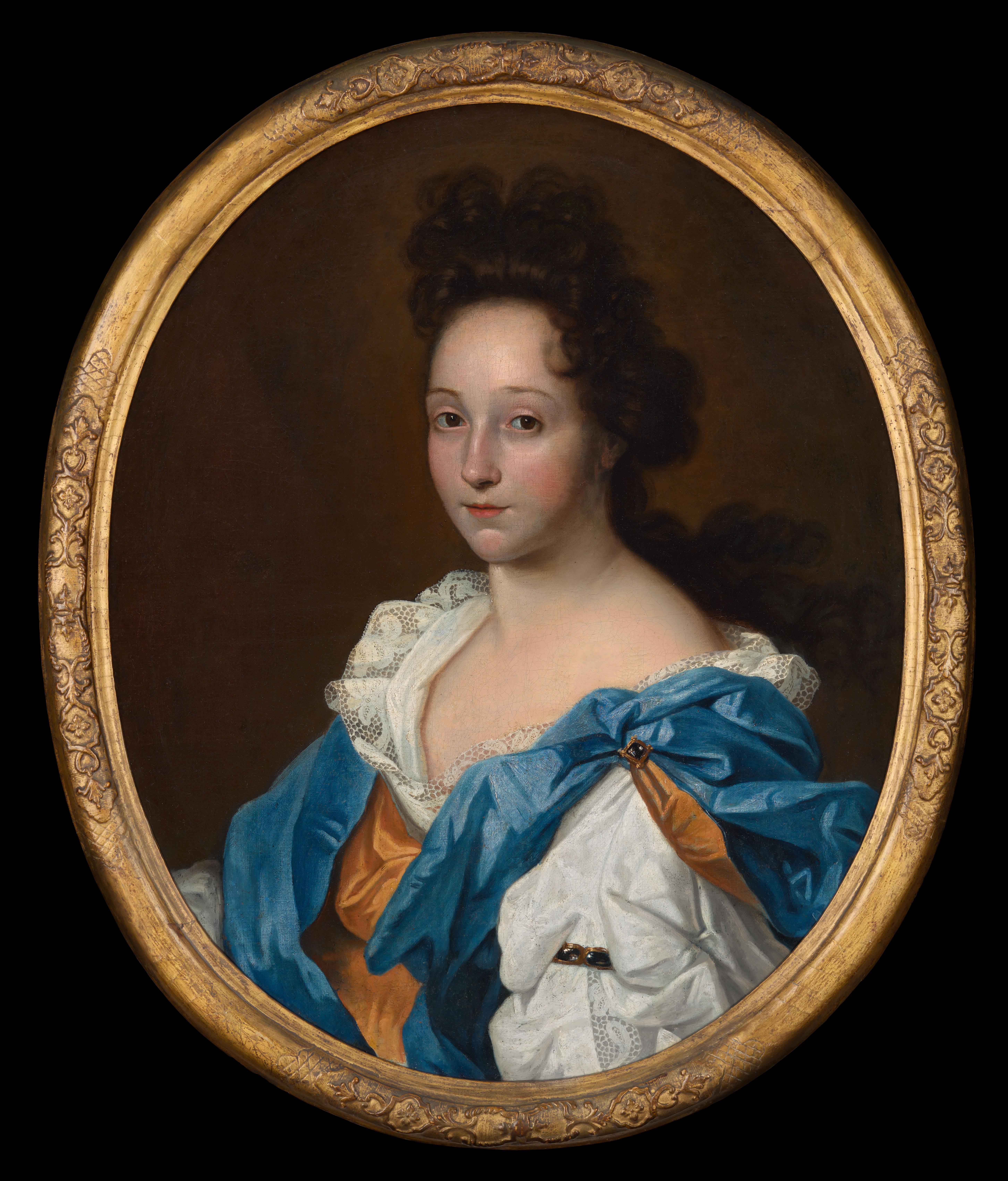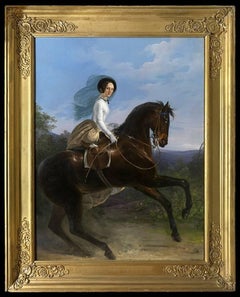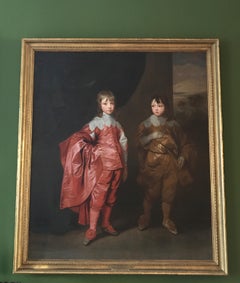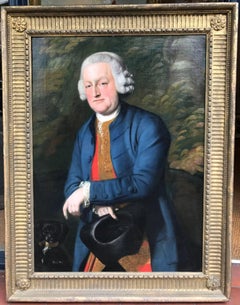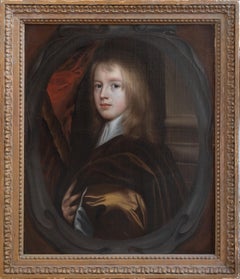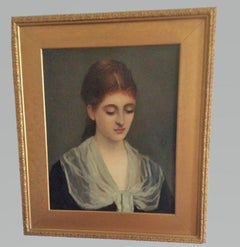18th Century Oil Painting Portrait of a Military Officer
View Similar Items
Want more images or videos?
Request additional images or videos from the seller
1 of 10
Nathaniel Dance-Holland18th Century Oil Painting Portrait of a Military Officerc. 1760-68
c. 1760-68
$25,928.71List Price
About the Item
- Creator:Nathaniel Dance-Holland (1735 - 1811, English)
- Creation Year:c. 1760-68
- Dimensions:Height: 36.5 in (92.71 cm)Width: 32 in (81.28 cm)
- Medium:
- Movement & Style:
- Period:1750-1759
- Condition:
- Gallery Location:London, GB
- Reference Number:1stDibs: LU67334547641
About the Seller
5.0
Vetted Professional Seller
Every seller passes strict standards for authenticity and reliability
Established in 1990
1stDibs seller since 2017
42 sales on 1stDibs
Authenticity Guarantee
In the unlikely event there’s an issue with an item’s authenticity, contact us within 1 year for a full refund. DetailsMoney-Back Guarantee
If your item is not as described, is damaged in transit, or does not arrive, contact us within 7 days for a full refund. Details24-Hour Cancellation
You have a 24-hour grace period in which to reconsider your purchase, with no questions asked.Vetted Professional Sellers
Our world-class sellers must adhere to strict standards for service and quality, maintaining the integrity of our listings.Price-Match Guarantee
If you find that a seller listed the same item for a lower price elsewhere, we’ll match it.Trusted Global Delivery
Our best-in-class carrier network provides specialized shipping options worldwide, including custom delivery.More From This Seller
View AllC19th Portrait Princesse de Joinville of Brazil - Spectacular fit for a palace
By Henri d'Ainecy Montpezat
Located in London, GB
Portrait of Princess de Joinville riding a Bay Horse
Henri d’Aincy, Le Comte Monpezat (French 1817-1859)
Painted circa 1837-9
oil on canvas
113 x 92 inches (including frame)
92 x 70 inches (unframed)
Provenance – from a private royal collection
This magnificent portrait depicts Princess de Joinville, the daughter of Pedro I, Emperor of Brazil and the King of Portugal. Through her illustrious family she was directly related Alexander III and Nicholas II of Russia and the Russian royal family, as well as to many of the great ruling families of Europe.
The work clearly confirms Monpezat as one of the most accomplished equestrian portrait painters in France in the early nineteenth century. In terms of scale, quality and dramatic power, it must surely be considered amongst his finest works. The stance of the powerful thoroughbred - in half rear - emphasises the calm nature and courage of the Princess.
Francisca of Brazil (1824-98) married a son of Louis Philippe I, the King of the French, and had three children. Born at the Imperial Palace of Saint Christopher, her youngest brother was the future Pedro II...
Category
1830s Old Masters Portrait Paintings
Materials
Oil
Double Portrait Oil Painting Brothers George, 2nd Duke Buckingham & Lord Francis
By (After) Anthony Van Dyck
Located in London, GB
Aftrer Anthony VAN DYCK - maybe Studio (1599, Antwerp – 1641, London) Flemish
Double Portrait of George Villiers, 2nd Duke of Buckingham (1628-1687) & Lord Francis Villiers (1629-1648)
Oil on Canvas
170 x 147 cm
Anthony Van Dyck (1599-1641)
No painter has done more to define an era than Anthony van Dyck. He spent only seven and a half years of his short life (1599- 1641) in England. He grew up in Antwerp, where his precocious talent was recognised by Peter Paul Rubens, the greatest painter of his age. He worked in Rubens’s studio and imitated his style as a religious artist, painting biblical scenes redolent of the lush piety of the counter-reformation. But soon he was on the move. In 1620, he visited London for a few months, long enough to paint a history picture, The Continence of Scipio, for the royal favourite, George Villiers, Marquess of Buckingham, and a portrait of his other English patron, the great art collector, Thomas Howard, 2nd Earl of Arundel.
After a stint in Italy, making imposing portraits of the wealthy aristocracy and sketching and copying works by Titian, he returned to the Spanish Netherlands in 1627, becoming court artist to Archduchess Isabella before departing for The Hague in 1631 to paint the Dutch ruler Frederick Henry, Prince of Orange. Charles I’s invitation in 1632 led Van Dyck back to London where he was knighted, paid an annual salary of £200 and installed in a house in Blackfriars with a special jetty at which the royal barge might tie up when the King was visiting his studio. By this time Van Dyck was recognised as the leading court painter in Europe, with Velazquez at the court of Philip IV of Spain his only rival. He also excelled as a superbly observant painter of children and dogs.
Van Dyck’s notoriety in depicting children led to the introduction of groups of children without their parents as a new genre into English painting (amongst other new genres).
For the next 300 years, Van Dyck was the major influence on English portraiture. Nearly all the great 18th Century portraitists, from Pompeo Batoni and Allan Ramsay to Thomas Gainsborough and Joshua Reynolds, copied Van Dyck’s costumes, poses and compositions.
George Duke of Buckingham & his brother Francis Villiers
Painted in 1635, this double portrait was originally commissioned by Charles I, who raised the two brothers after their father, George Villiers, was assassinated in 1628. Together with their sister, Lady Mary Villiers, they enjoyed the King’s favour absolutely. Francis whose absolute ‘inimitable handsomeness’ was noted by Marvell (who was killed in a skirmish near Kingston upon Thames). The young duke who commanded a regiment of horse at the Battle of Worcester, remained closely associated with Charles II, held a number of high offices after the Restoration and was one of the most cynical and brilliant members of the King’s entourage, immortalised as ‘Zimri’ in Dryden’s Absalom and Achitopbel. As a young man he had sold his father’s great collection of pictures in the Spanish Netherlands, many of them to the Archduke Leopold Willhelm.
Painted for Charles I and placed near the portrait of their sister in the Gallery at St James’ Palace. The handling of both costumes is very rich, and the heads are very carefully and sensitively worked. That of the younger boy in particular is more solidly built up than the lower part of the figure. A preparatory drawing for the younger boy is in the British Museum.
There are copies at, e.g., Highclere Castle...
Category
17th Century Old Masters Portrait Paintings
Materials
Oil
18th Century Oil Painting Portrait of Phillip, 6th Viscount Wenman.
By Nathaniel Dance-Holland
Located in London, GB
Sir Nathaniel Dance-Holland (1750-1811) was an English portrait painter and one of the founding members of the Royal Academy in 1768. Justly celebrated in his lifetime he won several...
Category
Late 18th Century Old Masters Portrait Paintings
Materials
Oil
17th Century Oil Painting Portrait of a Young English Boy
By Gerard Soest
Located in London, GB
Gerard SOEST (1600 - 1681)
Portrait of a Young Boy
oil on canvas
35.5 x 30.5 inches inc. frame
Gerard Soest (circa 1600 – 11 February 1681), also known as Gerald Soest, was a portra...
Category
17th Century Old Masters Portrait Paintings
Materials
Oil
Lady Dormore - A 16th Century Portrait of a key member of Shakespeare's England
Located in London, GB
Lady Dormer, Mary Browne
c. 1592
oil on panel
35 x 29 inches, unframed;
41 x 34.75 inches, inc. frame
Inscribed 'Lady Dormore'
Mary married Henry Wriothesley, 2nd Earl of Southampton who gave birth to Henry Wriothesley, 3rd Earl of Southampton - one of the great figures in Shakespears"s circle and founder of the Virginia company, developers of Virginia USA.
Henry Wriothesley, born 6 October 1573 at Cowdray House, Sussex, was the only son of Henry Wriothesley, 2nd Earl of Southampton, by Mary Browne, the only daughter of Anthony Browne, 1st Viscount Montague, and his first wife, Jane Radcliffe.[5] He had two sisters, Jane, who died before 1573, and Mary (c. 1567 – 1607), who in June 1585 married Thomas Arundell, 1st Baron Arundell of Wardour.[6]
After his father's death, Southampton's mother married firstly, on 2 May 1595, as his second wife, Sir Thomas Heneage (d. 17 October 1595), Vice-Chamberlain of the Household, and secondly, between 5 November 1598 and 31 January 1599, Sir William Hervey. She died in November 1607.[7]
Early life
When his father died on 4 October 1581 Southampton inherited the earldom and landed income valued at £1097 6s per annum. His wardship and marriage were sold by the Queen to her kinsman, Charles, Lord Howard of Effingham, for £1000. According to Akrigg, Howard then "entered into some further agreement, of which no documentation can now be found, which transferred to Lord Burghley personally the custody and marriage of the young Earl, but left Howard holding his lands", and late in 1581 or early in 1582 Southampton, then eight years of age, came to live at Cecil House in the Strand.[8]
In October 1585, at age twelve, Southampton entered St John's College, Cambridge,[9] graduating M.A. on 6 June 1589.[10] His name was entered at the Gray's Inn legal society before he left the university, and he was admitted on 29 February 1588.[11]
On Southampton's 16th birthday, 6 October 1589, Lord Burghley noted Southampton's age in his diary, and by 1590 Burghley was negotiating with Southampton's grandfather, Anthony Browne, 1st Viscount Montague, and Southampton's mother, Mary, for a marriage between Southampton and Lord Burghley's eldest granddaughter, Elizabeth Vere, daughter of Burghley's daughter, Anne Cecil, and Edward de Vere...
Category
16th Century Old Masters Figurative Paintings
Materials
Oil
Sir Anthony Van Dyck 17th Century Oil Painting Study of a Head of a Man
By Anthony van Dyck
Located in London, GB
Sir Anthony Van Dyck (1599-1641, Flemish)
Study of a Head of Man
Circa 1627-32, Van Dyck’s second Antwerp period
Oil on paper, laid down on canvas
Dimensions 15 x 14 inches (38.1 x 3...
Category
17th Century Old Masters Portrait Paintings
Materials
Oil
You May Also Like
19th century Portrait of a Lady, Attributed to Sir Frank Dicksee
Located in York, GB
Portrait of a very attractive Lady, head-and-shoulders in length
monogrammed FD, inscribed to verso, oil on canvas, 50cm x 40cm
whilst overall is 59 x 69 cm .
In overall good condition some craquelure. Has been relined and cleaned.
original frame some minor losses (self coloured)
Frank...
Category
19th Century Old Masters Portrait Paintings
Materials
Oil
$3,185 Sale Price
34% Off
Free Shipping
Portrait of Mrs Harborough - British 18th century art portrait lady oil painting
Located in London, GB
This lovely 18th century Old Master portrait oil painting is attributed to the circle of noted portrait artist Enoch Seeman. Seeman came from Poland to England as a youngster with hi...
Category
18th Century Old Masters Portrait Paintings
Materials
Oil
Portrait of a Lady with Pink Bow - British c 1820 Old Master art oil painting
By Sir Thomas Lawrence
Located in London, GB
This lovely British Old Master portrait oil painting is attributed to circle of Sir Thomas Lawrence. Painted circa 1820 it is a seated half length portrait of a beautiful lady in a b...
Category
1820s Old Masters Portrait Paintings
Materials
Oil
$13,295 Sale Price
20% Off
Portrait of Lady in Mob Cap - British Old Master 18th century art oil painting
Located in London, GB
This charming British Old Master Regency pastel portrait is attributed to John Russell RA. Painted circa 1790 the composition is a blonde woman in pretty mob cap with a blue ribbon. A really lovely image.
Provenance. Oxford estate.
Condition. Oil pastel on paper, 23 inches by 19 inches unframed and in good condition but has line in paper in middle.
Frame. Housed in a fine frame, 30 inches by 26 inches framed and in good condition.
John Russell RA (1745-1806) was an English painter renowned for his portrait work in oils and pastels, and as a writer and teacher of painting techniques. Russell was born in Guildford, Surrey, the son of John Russell Snr., book and print seller and five times mayor of the town; his father was something of an artist, and drew and published two views of Guildford. Russell was educated at the Royal Grammar School, Guildford, and soon showed a strong inclination for art. He trained under Francis Cotes RA (of Cavendish Square, London), one of the pioneers of English pastel painting, and, like Cotes, was an admirer of the pastel drawings of Rosalba Carriera whose methods influenced his technique of "sweetening". At the age of 19 he converted to Methodism, which was the cause of tension with his family and with his teacher; he made no secret of his strong evangelical leanings and would attempt to preach and convert at every opportunity. Russell set up his own studio, in London, in 1767. He made the acquaintance of the notorious Dr. William Dodd, whose portrait he painted in 1768. He was introduced to Selina, Countess of Huntingdon, who unsuccessfully attempted to persuade him to give up painting and attend her Methodist ministers' training college at Trevecca in Wales. On 5 February 1770, he married Hannah Faden, daughter of a Charing Cross print and map seller...
Category
18th Century Old Masters Portrait Paintings
Materials
Oil
Portrait of Boy Playing a Flute - 18th/19th century art Old Master oil painting
Located in London, GB
This interesting painting is a British Old Master late 18th century or early 19th century oil painting attributed to Thomas Barker of Bath. It is stylistically very similar to his ot...
Category
Early 1800s Old Masters Portrait Paintings
Materials
Oil
Lady Eleanor Dundas - Old Master 18C Scottish art oil painting female portrait
By Henry Raeburn (circle)
Located in London, GB
A fine large and stunning Scottish Old Master portrait oil painting on canvas portrait in good condition which depicts Lady Eleanor Dundas in a white dress set against an open landsc...
Category
19th Century Old Masters Portrait Paintings
Materials
Oil
